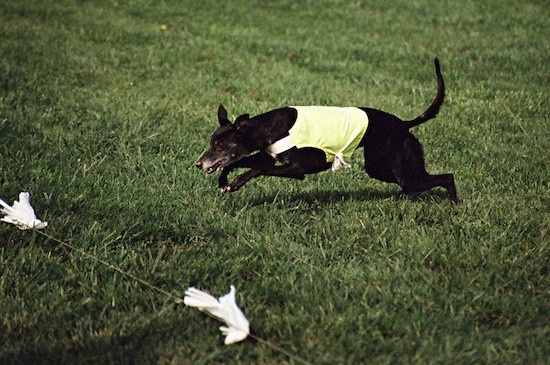
Picture courtesy of David Hancock
Lure Coursing is a sport for sighthounds. This sport dates back to ancient times and was popular among nobility. During this sport, the sighthounds are encouraged to chase a lure as fast as they can. This sport takes place in a large open field and uses about 600–800 yards. A lure with white plastic is tied to a long rope pulley system that stretches across a wide open space. By pressing a switch, you can control the speed which would make the lure go faster than 40mph. The white lure is then very quickly slid across the rope in order for the dog to chase. This action resembles a small animal running across the field. The goal is for the dog to catch the white lure faster than any of the other dogs. Official coursing clubs include the AKC (American Kennel Club), ASFA (American Sighthound Field Association), FCI (Fédération Cynologique Internationale), or the CKC (Canadian Kennel Club).
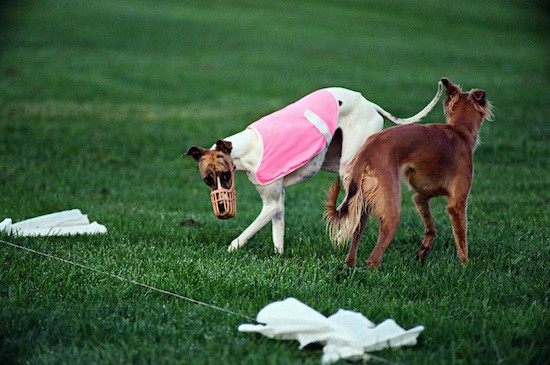
Picture courtesy of David Hancock
In ancient times, owners used to have their dog chase live game for sport. In modern times, we call this Lure Coursing. Traditionally, sighthounds are the only dog type to participate in this sport. Sighthounds were originally bred for chasing and hunting small animals such as pigs, foxes, and rabbits. They also commonly hunted antelope or deer.
Around 4,000 years ago, this sport was popular among the Egyptians as they used their hounds known for their long legs. Later, it was quite popular for rich landowners to participate or host the sport. In the Medieval times, it was again a popular sport among the wealthy and nobility. English Common folk were banned from owning Greyhounds for a long while because they were the most popular dog for the sport.
A newer, updated version of the sport was created in the 1970s. Instead of using live game, they now used a portable mock lure on a pulley system. They did this so there were less incidents or harmful events happening between the live animal and the dog. This new system was designed in California by Lyle Gillette and other wealthy Lure Coursing officials.
The first step to is to decide whether you want to enter your dog in competitions. To do this, it is recommended that you first put your dog through a non-competitive lure course in order to gauge your dog’s abilities. These courses are great for measuring your sighthounds abilities and learning how to improve their skill.
Secondly, you must familiarize yourself with the rules of this sport. To do this, the most effective way is to read through a Lure Coursing guidebook. There are many available online, including on the website for the AKC.
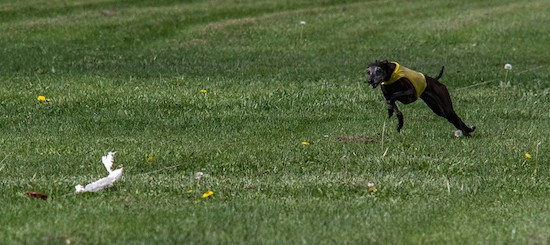
Picture courtesy of David Hancock
Third, there are Lure Coursing Tests in order for your dog to be eligible in the sport. Your dog may either qualify for a Junior Courser or a Senior Courser. To qualify for the Junior Courser, the dog must run alone for 600 yards in front of two different judges for four turns. In order to qualify for a Senior Courser, your dog must already qualify as a Junior Courser. For this course, your dog must run an Open Stake course alongside one other dog in front of two different judges, four times. They must earn a qualifying score in order to be a Senior Courser. If your dog earns 25 qualifying scores, has a Senior Courser title, and earns these scores in either Open Veteran, Open, or Specials Stake courses, your dog will be a Master Courser.
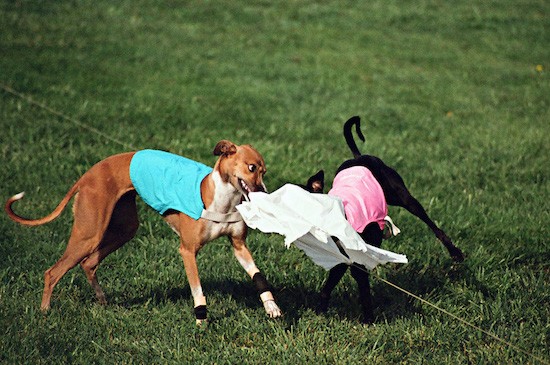
Picture courtesy of David Hancock
If dogs in running pairs are not slipped together, there may be penalties. You may acquire penalties penalties if your dogs are not slipped when commanded or if both dogs have either an early or late release (also known as a preslip or post slip).
If dogs are muzzled by the owner, both dogs must be muzzled if they are running in pairs.
If one dog out of a pair is disqualified, the other dog may run again for free as long as it’s with the same breed. This may either be any dog that has already run or a trial dog. Both of these dogs must wear coats in order for the judges not to know that only one dog is left in the competition.
Sighthounds must be at least or older than one year in order to participate.
Judges are allowed to disqualify the sighthounds at any point during the game for a variety of reasons.
If your dog is not under starters, they must be on a leash. Not following this rule will result in a fine.
If there are more than 6 or 6 of the same breed running in a single run, the dogs are expected to be in pairs unless any of the following five occurrences apply.
1. If they are a Veteran, they may run either in pairs or single.
2. If they are new and this is their first or second meeting, the owner may choose if their dog runs alone or in a pair.
3. If your dog has less than 6 entries, the owner may choose if they run in pairs or alone.
4. Dogs with over 5 entries must run in pairs in order to be entered in the category Best of Breed.
5. In order for the category Best of Breed to be won, there must be at least four dogs in the breed category.
6. Dogs must be cleaned up after with plastic bags provided for the event and all litter must be thrown out in the appropriate bin or sack.
7. Humans must stay in designated areas until their dog is up for their event.
8. The dog must have either a red or white coat in order to run.
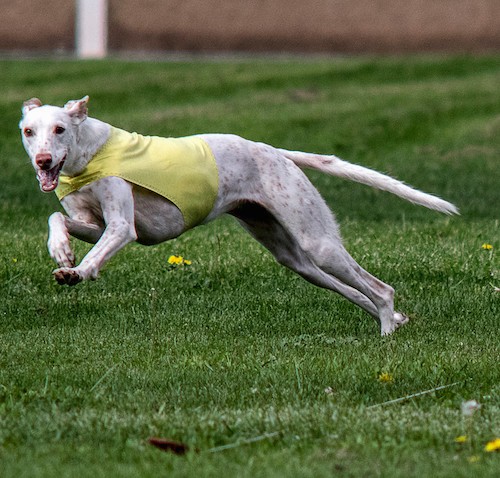
Picture courtesy of David Hancock